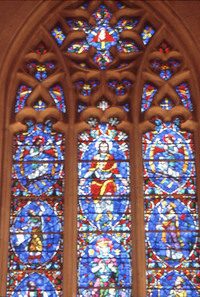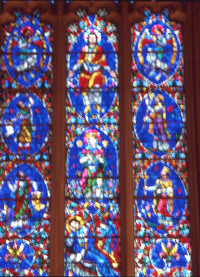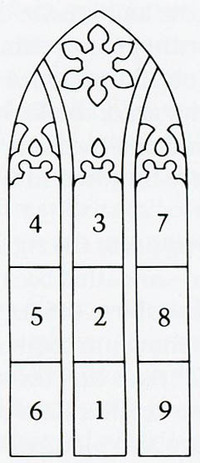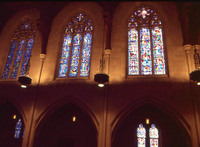Window
Building Name: Kirk in the HillsStudio Name: Burnham (W. H.) Studios
City: Bloomfield Hills
Window Shape: 6 (gothic arched, more than 2 vertical sections)
Subject/Title of Window: The Stem of Jesse
Brief Description of Subject: From "Welcome to the Kirk."
The Kirk is the only church in which the entire life of Christ is brilliantly illustrated in stained glass.
The Chancel window portrays His Passion; the Narthex window portrays His Resurrection. The eight clerestory windows reflect the story of His life in scores of scenes, replete with color and meaning. And the seven side aisle windows tell the story of His prayer in the colorful drama of stained glass. Thus, sitting in the Nave, the worshipper is surrounded by Christ. The entire story of His life and work, His death and Resurrection, is made visibel to adult and youngster alike. He is seen everywhere in the Kirk's marvelous monuments in stained glass - to comfort those who would contemplate, to teach those who seek to broaden their Christian knowledge.
The two sets of stained glass windows on either side of the Nave are among the finest in the United States for their clarity of design and colorful composition. Months of painstaking research and continuing correspondence and conferences between the designers and church officials went into their creation. What's more, all the Kirk windows employ the colors and general patterns used in the famous Chartres Cathedral in France. This world-famed edifice is noted for the beauty of its unusual spires, its statuary and - most especially - its outstanding 13th century stained glass windows.
The Kirk's eye-catching windows add glistening shades of color to highlight the loft grandure of the arching Gothic Nave. Every window in the clerestory grouping has its individual, distinct color tone. Each window naturally contains all the primary colors, but each features one of them. For instance, on the west wall, the first window (Jesse) is predominately blue. The second window (Annunciation and Birth) features blue and gold. The third window is approximately seven feet wide and seventeen feet high and note that, in all the windows, the medallions have been employed in such a manner so as not to be bold or conspicuous in outline. Further, they are varied in shape and form to avoid duplication and the monotonous appearance of horizontal rows.
Continuing clockwise around the clerestory grouping, the fourth window in the series is located nearest the Chancel on the east wall and depicts the outstanding Acts in Christ's Life (other than the healing miracles). Next to it come windows portraying the Teachings of Christ (other than those in the Parables), the Parables of Christ, Christ's Miracles of Healing and the beginnings of His ministry.
Since the Middle Ages, stained glass windows have been a source of inspiration to churchgoers of every generation. Before printing made the Bible available to everyone, people could read its majestic messages in the strking stained glass of Europe's great cathedrals. These illuminating windows were called "Biblia pauperum," or books of the poor.
The themes for all the Kirk windows were arranged by the late Dr. DeWindt, who made a trip to Europe to study the great Gothic churches in France and Italy. After many consultations with artists and stained glass experts, it was decided to engage two of the most celebrated stained glass studios in America to design and produce the Kirk windows - Joseph G. Reynolds and Associates and Wilbur Herbert Burnham, both of Boston.
Two studios were chosen because neither firm was large enough to do the entire job in less than eight years. Furthermore, by having two studios work on this major undertaking, greater variety in design and execution was achieved. The Kirk windows are all double-glazed; that is, there is a transluscent exterior glass on the outside that forms a storm window to protect the stained glass design and the cames (lead pieces) from the elements. Each studio created four of these windows. Mr. Burnham designed windows 1, 3, 5 and 7, and Mr. Reynolds did 2, 4, 6 and 8.
The Jesse Window
1 - The Calling of Jesse (Is. 11:1-5);
2 - Mary, blessed among women (Luke 1:42);
3 - Jesus Christ, Our Lord (Is. 9:6);
4 - An adoring angel;
5 - Prophet with scroll (Is. 53:1,3-5);
6 - Prophet with scroll (Jere. 23:5-6);
7 - An adoring angel;
8 - King with scepter (Ps.100);
9 - King with scepter (Ps. 117).
The Hand of God, the Father, is shown at the apex of the window; and the two small circles at the bottom incorporate various symbols of the Trinity.
Condition of Window: Good
Height: 17'
Width: 7'
Type of Glass and Technique: Antique or Cathedral Glass, Lead Came
The Stem of Jesse upper
The Stem of Jesse lower
Window key
Life of Christ Overview
The MSGC is a constantly evolving database. Not all the data that has been collected by volunteers has been sorted and entered. Not every building has been completely documented.
All images in the Index are either born-digital photographs of windows or buildings or are scans of slides, prints, or other published sources. These images have been provided by volunteers and the quality of the material varies widely.
If you have any questions, additions or corrections, or think you can provide better images and are willing to share them, please contact donald20@msu.edu






